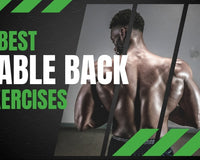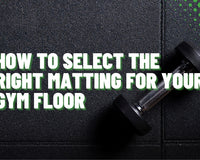As someone who is just exploring the world of fitness, you might not be too sure as to what dips are or what they are designed to do.
Today, we’re going to find out everything that you need to know about dips to determine whether or not it’s an exercise you should add to your workouts.
So, what muscles do dips work?
What is a Dip?

Dips are a common exercise that can be performed in a gym setting, at home, and anywhere there is a good spot to do so.
What can get a bit confusing is that there are a few different types of dips, including chest dips, triceps, bench dips, and others.
However, although there are different types of dips, the movement with all of them is quite similar.
The basic version of the dip involves supporting yourself with your arms with your elbows bent, while lowering yourself down so that the upper arm, the triceps, is parallel to the ground, followed by pushing yourself back up to the original starting position.
Most people consider dips to be a great bodyweight exercise, although it is possible to increase the difficulty level by adding some weights or resistance bands to the mix.
Types of Dips and How to Do Them
As mentioned above, there are several types of dips that you can do, and which one you choose will determine which muscles are targeted the most, something we will touch on further below.
The Chest Dip

One of the most common types of dip is the chest dip, which is usually done on a power tower with dip handles, although it can also be done with countertops, raised benches, and even chairs.
Here, you start by holding the handles of the power tower, with your feet on the rests.
Using your arms, lift up your whole body so that your arms are fully extended vertically, and so that your feet are hanging below you.
You can keep your legs straight when doing dips, although most people will bend their knees.
Make sure that your wrists are positioned a little bit behind your shoulders.
As you lower your body down by bending at the elbow, lean forward a little bit, and then stop once your upper arm is parallel to the ground.
You can then push back up to return to the starting position.
As you can probably guess, this is a great exercise for your chest. If you want to increase the difficulty level, you can always use some weight.
There are special dip belts that have a chain to allow you to connect weight plates and hang them between your legs.
Some people also grab a dumbbell between their legs to add extra weight although it is as convenient as having the proper belt.
Triceps Dips

We then have the triceps dip. This is generally the same as the chest dip, with one minor difference.
The start here looks exactly the same, with you propping yourself up on the power tower with your arms straight up and your feet hanging below you.
The only real difference between the chest dip and the triceps dip is that with the triceps dip when you lower your body down during the rep, you keep your body as vertical as you can. As opposed to the chest dip, where you lean forward a little bit.
This slight change in position focuses more of the weight onto your triceps and takes some of the pressure off your chest.
Once again, you can always increase the difficulty level by adding more weights to the equation.
Related: Grow triceps with the best dumbbell tricep exercises.
The Double Bench Dip
Next, we have the double bench dip, which involves using a pair of benches to do your dips as opposed to the power tower.
Here, you would take two benches, or chairs, and place them across from one another. Sit on one side and hold the edge of the chair or bench with your palms facing backward and your fingers facing you.
Take your feet and put them on the other bench or chair that is in front of you. Then, using your arms, lift yourself up and use your core for stability, making sure that your backside is no longer touching the bench.
Move your body forward ever so slightly and lower it down until your elbows have a 90-degree bend in them.
If you're doing this properly, at the bottom of the movement, the small of your back should be level with the bench. You can then push yourself back up to the starting position.
If you are just getting stated and want a slightly easier dip alternative, you can perform this exercise with just one bench and have your feet on the floor.
What Muscles Do Dips Work?

Now that we know what dips are and how to do them, let’s take a closer look at the main muscles in which all of these dips variations work.
If we are talking about chest dips, as you can probably guess by the name, they work mostly on your chest, as well as the surrounding muscles.
Both your major pectoralis and minor pectoralis muscles benefit the most from the chest dip, however, the anterior deltoid, triceps, rhomboids, levator scapulae, and latissimus dorsi are all engaged as well. To a lesser degree, the traps are activated too.
In terms of the triceps dips, if you assumed that these are best for targeting your triceps, you would be completely correct.
However, other muscles are also involved here, mainly both your major and minor pecs, the anterior deltoid, rhomboids, lats, and your back in general. You also need your traps for stability.
As you can see, the chest dip is all about the chest with a bit of triceps, shoulders, lats, and back, whereas the triceps dip is all about the triceps, along with a bit of chest, shoulders, lats, and back.
Why You Should Consider Adding Dips to Your Routine
Let's take a quick look at why both chest dips and triceps dips are fantastic exercises to add to your regular routine.
They’re Excellent for Gaining Muscle Mass
By far one of the biggest benefits that you get from all types of dips is that they are fantastic for strengthening your muscles.
Yes, you have to perform the dips with proper form, and depending on how you do them, you'll target either your triceps or your chest muscles more.
If you can do anywhere between 6 and 12 reps, for three to five sets you will be causing your muscles to grow through hypertrophy.
Maintaining A Range of Motion
Every time you do a dip, your shoulders and arms have to go through a full range of motion.
As long as you do this safely and without too much weight, it should help improve your overall joint health and mobility.
The more you exercise your mobility, the better it will become over time.
If you already have great mobility and a full range of motion, at the very least, these dips will help maintain it.
Scalability
Something else worth pointing out about dips is that they are very easy to scale.
Of course, you have to have a certain level of strength to do even a single dip, because you effectively have to be able to with your own body weight.
However, it's very easy to progress with dips, because you can constantly add more weight to the equation.
All you have to do is strap some weight plates to your midsection, and you're good to go.

Convenience
The other factor to consider here is that the dips are just really easy to do in general no matter where you are.
As long as you have a bench, some chairs, a power tower, or even a raised stable surface, doing dips is more than possible.
Dips are also a movement that you will use in everyday life which means you will find certain tasks easier. For example, getting out of the bath is basically a dip movement.
Rounding Up

The bottom line here is that if you need a good set of exercises for your triceps and chest muscles, then there isn't much better than the dip.
Frequently Asked Questions
1. Do dips work your chest? - Yes, no matter what type of dip you perform, dips will train your chest.
2. Do dips work your shoulders? - Yes, dips will work some muscles in your shoulders. When performing dips, the main shoulder muscles engaged are the front deltoids and a bit of lateral delts. But they don't work your rear deltoids.
3. Do dips work your back? - No, dips don't engage your back muscles. So if you are looking for a back exercise you will need to consider movements such as pull ups.





